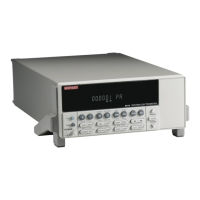Remote Operation 12-15
Command path rules
• Each new program message must begin with the root command, unless it is optional
(e.g., [:SENSe]). If the root is optional, simply treat a command word on the next level
as the root.
• The colon (:) at the beginning of a program message is optional and need not be used.
:stat:pres = stat:pres
• When the path pointer detects a colon (:), it moves down to the next command level. An
exception is when the path pointer detects a semicolon (;), which is used to separate com-
mands within the program message.
• When the path pointer detects a colon (:) that immediately follows a semicolon (;), it
resets to the root level.
• The path pointer can only move down. It cannot be moved up a level. Executing a com-
mand at a higher level requires that you start over at the root command.
Using common commands and SCPI commands in the same message
Both common commands and SCPI commands can be used in the same message as long as
they are separated by semicolons (;). A common command can be executed at any command
level and will not affect the path pointer.
:stat:oper:enab <NRf>; *ESE <NRf>
Program Message Terminator (PMT)
Each program message must be terminated with an LF (line feed), EOI (end or identify), or
an LF+EOI. The bus will hang if your computer does not provide this termination. The following
example shows how a program message must be terminated:
:trac:poin 10 <PMT>
Command execution rules
• Commands execute in the order that they are presented in the program message.
• An invalid command generates an error and, of course, is not executed.
•Valid commands that precede an invalid command in a multiple command program mes-
sage are executed.
•Valid commands that follow an invalid command in a multiple command program mes-
sage are ignored.
•For fastest command execution:
1. Do not use optional command words (i.e., [:SENSE [1]]).
2. Do not use the colon (:) at the beginning of a program message.
3. Always use the short-form versions of commands and parameters.
4. Minimize the amount of “white” space in command strings.
5. Keep numeric parameters simple (i.e., 1 vs. 1.000e + 00).
6. Use all upper-case.

